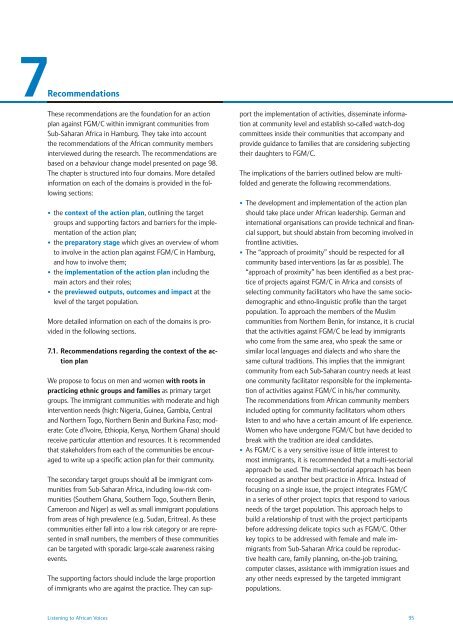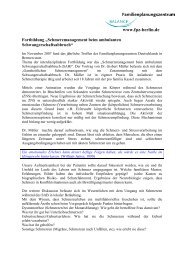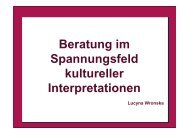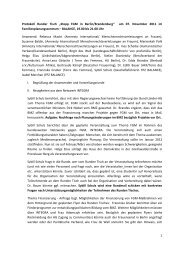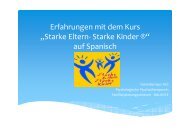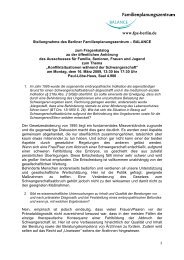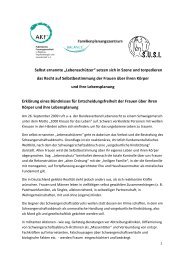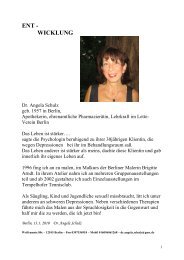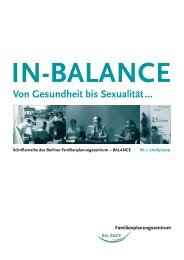7RecommendationsThese recommendations are the foundation for an actionplan against FGM/C within immigrant communities fromSub-Saharan Africa in Hamburg. They take in<strong>to</strong> accountthe recommendations of the <strong>African</strong> community membersinterviewed during the research. The recommendations arebased on a behaviour change model presented on page 98.The chapter is structured in<strong>to</strong> four domains. More detailedinformation on each of the domains is provided in the followingsections:• the context of the action plan, outlining the targetgroups and supporting fac<strong>to</strong>rs and barriers for the implementationof the action plan;• the prepara<strong>to</strong>ry stage which gives an overview of whom<strong>to</strong> involve in the action plan against FGM/C in Hamburg,and how <strong>to</strong> involve them;• the implementation of the action plan including themain ac<strong>to</strong>rs and their roles;• the previewed outputs, outcomes and impact at thelevel of the target population.More detailed information on each of the domains is providedin the following sections.7.1. Recommendations regarding the context of the actionplanWe propose <strong>to</strong> focus on men and women with roots inpracticing ethnic groups and families as primary targetgroups. The immigrant communities with moderate and highintervention needs (high: Nigeria, Guinea, Gambia, Centraland Northern Togo, Northern Benin and Burkina Faso; moderate:Cote d’Ivoire, Ethiopia, Kenya, Northern Ghana) shouldreceive particular attention and resources. It is recommendedthat stakeholders from each of the communities be encouraged<strong>to</strong> write up a specific action plan for their community.The secondary target groups should all be immigrant communitiesfrom Sub-Saharan Africa, including low-risk communities(Southern Ghana, Southern Togo, Southern Benin,Cameroon and Niger) as well as small immigrant populationsfrom areas of high prevalence (e.g. Sudan, Eritrea). As thesecommunities either fall in<strong>to</strong> a low risk category or are representedin small numbers, the members of these communitiescan be targeted with sporadic large-scale awareness raisingevents.The supporting fac<strong>to</strong>rs should include the large proportionof immigrants who are against the practice. They can supportthe implementation of activities, disseminate informationat community level and establish so-called watch-dogcommittees inside their communities that accompany andprovide guidance <strong>to</strong> families that are considering subjectingtheir daughters <strong>to</strong> FGM/C.The implications of the barriers outlined below are multifoldedand generate the following recommendations.• The development and implementation of the action planshould take place under <strong>African</strong> leadership. German andinternational organisations can provide technical and financialsupport, but should abstain from becoming involved infrontline activities.• The “approach of proximity” should be respected for allcommunity based interventions (as far as possible). The“approach of proximity” has been identified as a best practiceof projects against FGM/C in Africa and consists ofselecting community facilita<strong>to</strong>rs who have the same sociodemographicand ethno-linguistic profile than the targetpopulation. To approach the members of the Muslimcommunities from Northern Benin, for instance, it is crucialthat the activities against FGM/C be lead by immigrantswho come from the same area, who speak the same orsimilar local languages and dialects and who share thesame cultural traditions. This implies that the immigrantcommunity from each Sub-Saharan country needs at leas<strong>to</strong>ne community facilita<strong>to</strong>r responsible for the implementationof activities against FGM/C in his/her community.The recommendations from <strong>African</strong> community membersincluded opting for community facilita<strong>to</strong>rs whom otherslisten <strong>to</strong> and who have a certain amount of life experience.Women who have undergone FGM/C but have decided <strong>to</strong>break with the tradition are ideal candidates.• As FGM/C is a very sensitive issue of little interest <strong>to</strong>most immigrants, it is recommended that a multi-sec<strong>to</strong>rialapproach be used. The multi-sec<strong>to</strong>rial approach has beenrecognised as another best practice in Africa. Instead offocusing on a single issue, the project integrates FGM/Cin a series of other project <strong>to</strong>pics that respond <strong>to</strong> variousneeds of the target population. This approach helps <strong>to</strong>build a relationship of trust with the project participantsbefore addressing delicate <strong>to</strong>pics such as FGM/C. Otherkey <strong>to</strong>pics <strong>to</strong> be addressed with female and male immigrantsfrom Sub-Saharan Africa could be reproductivehealth care, family planning, on-the-job training,computer classes, assistance with immigration issues andany other needs expressed by the targeted immigrantpopulations.<strong>Listening</strong> <strong>to</strong> <strong>African</strong> <strong>Voices</strong> 95
• In order <strong>to</strong> encourage an attitude of change relative <strong>to</strong>FGM/C, the target populations need discussion forums<strong>to</strong> question the numerous benefits associated withFGM/C. This is why a one-dimensional approach based onawareness raising of the risks and harmful consequencesof FGM/C will have limited reach. Parallel <strong>to</strong> providinginformation on the medical, sexual and psychological effectsof FGM/C, it is indispensable <strong>to</strong> encourage debates inwhich prejudices <strong>to</strong>wards non-circumcised women and thepositive perceptions of FGM/C are questioned. This canbe done within the scope of a multi-dimensional approachwhich comprises a focus on awareness-raising, but also anemphasis on creating spaces in which <strong>to</strong> discuss the mythsand beliefs related <strong>to</strong> the practice and <strong>to</strong> question thebenefits perceived by men and women of different origins.• Open and silent supporters of the practice are foundamong both men and women. Although the practice isoften called “women’s business”, this is far from being thetruth. Both men and women contribute <strong>to</strong> the dynamicmaintaining FGM/C, both have a right <strong>to</strong> be informedabout the risks and harmful consequences of the practice,and both have a role <strong>to</strong> play in its abandonment. Werecommend, thus, the involvement of both women andmen immigrants of all ages in the activities and <strong>to</strong> adaptthe nature of the activities <strong>to</strong> gender-specific needs. Girland boy children are a very receptive target group andit is suggested that child and youth-friendly activities beincluded in the action plan.7.2. Recommendations regarding the prepara<strong>to</strong>ry stageThe recommendations for this stage stem from the idea oforganising the preparations in four chronological phases:The first phase consists of the establishment of a Pan-<strong>African</strong>Committee (PAC). The idea of setting up a committeewith representatives from immigrant communities ofmultiple Sub-Saharan countries arose during the research.Most members of the research team shared a common visionand expressed a strong willingness <strong>to</strong> continue promotingthe abolition of FGM/C. They had gathered and exchangedmany experiences during the two months of data collectionand established a strong network of contacts across theimmigrant communities. The recommended activities for thefounding members of the PAC are <strong>to</strong> define their mission,their vision and their intervention domains at this stage,and <strong>to</strong> work <strong>to</strong>ward making their organisation functional.It is suggested that at least one member be mobilised percountry (from Sub-Saharan Africa) and <strong>to</strong> invite the researchparticipants who expressed interest in contributing <strong>to</strong> activitiesagainst FGM/C <strong>to</strong> join the organisation.The second phase of the prepara<strong>to</strong>ry stage will be the disseminationof the research results. The suggested targetgroups for dissemination are stakeholders of the immigrantcommunities from the participating countries (includingreligious and cus<strong>to</strong>mary leaders, focal points of country andregional/state immigrant associations and women’s groups).The activities should try <strong>to</strong> reach as many immigrants aspossible and invite them <strong>to</strong> debate the results. In the processof dissemination, we recommend that the participants fromthe various communities be asked whether any of them isinterested in writing up an action plan against FGM/C fortheir community of origin.Further proposed target groups for information disseminationare the German authorities and government representatives,the civil society (e.g. NGOs, human rights activists) aswell as relevant professional groups (teachers, social workers,reproductive health professionals).The third phase takes place after the information has beendisseminated. Interested representatives of immigrants’associations from different countries of origin are supportedin the development of action plans for the abolition ofFGM/C. The recommended elements for the specifi c actionplan are:• Provision of general support and orientation for the targetedimmigrant populations;• Cultural activities acknowledging the values of <strong>African</strong>traditions;• Awareness raising through films, radio spots, informationleafl ets, theatre and other strategies on the risks andharmful consequences of FGM/C, the position of religion<strong>to</strong>wards the practice, the position taken by the Germanlegal system and global trends and initiatives on FGM/C;• Debates and round-table discussions on the advantagesand disadvantages of the practice;• Community-based advocacy for the abandonment ofFGM/C encouraging community leaders <strong>to</strong> speak outagainst the practice;• The establishment of watchdog committees with the aimof sensitising parents who travel with a daughter <strong>to</strong> theircountry of origin.• The recommended meeting locations are Afro Shops,<strong>African</strong> restaurants and hairdressers or barber shops.In the fourth stage, the specific action plan will be revisedand compiled in<strong>to</strong> one general action plan by the PAC.We propose that two main sections be included in thegeneral action plan: (1) the specific action plans targetingmembers of particular communities and (2) capacity-buildingactivities (for the immigrant associations, the PAC, reproductivehealth workers etc.) as well as large-scale awarenessraising and advocacy at city, national and international levels.Once the general action plan is finalised, it can be submitted<strong>to</strong> the City of Hamburg and donor organisations for funding.96<strong>Listening</strong> <strong>to</strong> <strong>African</strong> <strong>Voices</strong>


